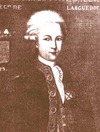WENGER, JOHANNES (later known as John Winger), Tunker bishop; b. in Lancaster County, Pa, son of Christian Wenger; m. 24 Aug. 1777 Elizabeth Eschlemann, and they had 10 children; d. 1827 at Black Creek, Bertie Township, Upper Canada.
Johannes Wenger grew up in Lancaster County among German and Swiss settlers who had emigrated in search of religious freedom. Family tradition told that his grandmother had left Switzerland to avoid having to attend the Roman Catholic church on the occasions required by law. Wenger became one of the leaders of the Brethren in Christ, known in Canada also as Tunkers, a pietistic group which emerged in Pennsylvania during the 1770s. He shared the Mennonite background of some of the early Brethren ministers, including the founder, Jacob Engel. The new church, however, also adopted many practices of the German Baptists of the area, particularly baptism by trine immersion.
The majority of the Brethren in Christ remained in Pennsylvania after the American Revolutionary War. Those who did emigrate considered themselves to be loyalist in spirit, although their pacifist principles had prevented them from bearing arms. In 1788 Wenger led a group of family and neighbours to the Niagara Peninsula. They first settled at the Short Hills, reminiscent of their hilly homeland in Pennsylvania. Here they experienced the hardships of 1788–89, known as the “hungry year,” and in 1792 a violent storm laid waste their crops and buildings. Some time between 1792 and 1797 Wenger and his family relocated in Bertie Township.
Wenger appears to have held the offices of elder and overseer (bishop) on his arrival in the Niagara Peninsula. Under his leadership a small congregation was established at Short Hills, and on his removal to Bertie Township the largest Upper Canadian congregation was formed. As meetings were held in homes or barns, church buildings were not immediately required. Wenger did set aside a plot on his farm, on the banks of Black Creek, for a cemetery. He also supervised the formation of congregations in York County and what was later to be Waterloo County.
Wenger must have been involved in prompting legislation affecting his co-religionists. By the Militia Act of 1793 Quakers, Mennonites, and Tunkers could be exempted from military service upon an annual payment of £1 in peace-time or £5 in time of invasion or insurrection. The exemption depended on presentation of a certificate of membership in one of those sects, and since adult baptism was practised, many young men would reach military age before attaining church membership. An act of 1810 remedied that difficulty. On a different front, in 1794 Mennonites, Tunkers, and others petitioned that their ministers be permitted to solemnize marriages. Action was postponed until after Lieutenant Governor Simcoe*’s departure. At the end of 1798 a marriage act came into force allowing Church of Scotland, Lutheran, and Calvinist ministers the right to celebrate matrimony, and Tunkers were presumed to be included under the rubric of Calvinist. Tunker tradition credits Wenger with being the first non-Anglican clergyman to be so authorized.
Wenger would have grown a beard (perhaps without moustache), kept his hair long and parted in the middle, and worn the coat of home-made cloth and the low, broad-rimmed hat of Tunker fashion. The image of patriarch is appropriate for one who combined the roles of pioneer farmer and church leader. As for the political developments in which he undoubtedly played a part, the legal concessions that allowed Tunkers to retain their pacifist principles, acknowledged their practice of adult baptism, and recognized marriages performed by their clergy contributed to the development of religious pluralism in Upper Canada.
PAC, RG 1, L3, 522: W2/100 (mfm. at AO). Corr. of Lieut. Governor Simcoe (Cruikshank), 3: 4. “U.C. land book B,” AO Report, 1930. A. W. Climenhaga, History of the Brethren in Christ Church (Nappanee, Ind., 1942). George Cober, A historical sketch of the Brethren in Christ Church, known as Tunkers in Canada, with Supplement . . . (Gormley, Ont., [1953?]), 5–6, 43. The history of the county of Welland, Ontario . . . ([Welland], 1889; repr. with intro. by John Burtniak, Belleville, Ont., 1972). Origin and history of the Tunker Church in Canada as gathered from authentic and reliable sources, comp. Asa Bearss and Wellington Duxbury (Ridgeway, Ont., 1918). G. E. Reaman, The trail of the black walnut (Toronto, 1957). E. M. Sider, “History of the Brethren in Christ (Tunker) Church in Canada” (ma thesis, Univ. of Western Ont., London, 1955); “The early years of the Tunkers in Upper Canada,” OH, 51 (1959): 121–29.
© 1987–2024 University of Toronto/Université Laval
Cite This Article
Richard E. Ruggle, “WENGER, JOHANNES,” in Dictionary of Canadian Biography, vol. 6, University of Toronto/Université Laval, 2003–, accessed April 26, 2024, http://www.biographi.ca/en/bio/wenger_johannes_6E.html.
The citation above shows the format for footnotes and endnotes according to the Chicago manual of style (16th edition). Information to be used in other citation formats:
| Permalink: | http://www.biographi.ca/en/bio/wenger_johannes_6E.html |
| Author of Article: | Richard E. Ruggle |
| Title of Article: | WENGER, JOHANNES |
| Publication Name: | Dictionary of Canadian Biography, vol. 6 |
| Publisher: | University of Toronto/Université Laval |
| Year of publication: | 1987 |
| Year of revision: | 1987 |
| Access Date: | April 26, 2024 |







